- Yokohama-shi Top Page
- Seya Ward Top Page
- Living and Procedures
- Community Development and Environment
- Green eco
- I can do it.
- Power Saving Awareness Project
- Introducing ideas to stay warm at room temperature of 20°C! [Winter Power Saving]
Here's the text.
Introducing ideas to stay warm at room temperature of 20°C! [Winter Power Saving]
We will introduce the idea of staying warm at room temperature of 20 ° C as "Warm Style Seya"!
Last Updated November 20, 2020
I think that many homes use air conditioners in winter following summer as the main heating equipment.
In winter, the energy saving effect by adjusting the room temperature setting of the air conditioner is higher than in summer.
Why don't you work on power saving in winter and saving electricity bills with "Warm Style Seya" to lower the set temperature of heating and live warmly?
Warm style tips <cloth>
Warm the "three necks" of your neck, wrist, and ankle
Utilize mufflers, gloves and leg warmers
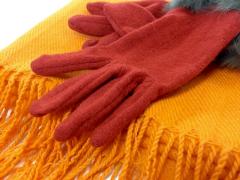
By focusing on the areas with thick blood vessels, the whole body warms up and helps to improve coldness.
After taking a bath, put a towel around your neck when you sleep, warm your body.
Let's focus on "materials" and warm up stylishly.
Let's try to wear underwear made of functional materials
Warm your trunk, conscious of the material of the underwear you use, such as an inner layer such as a T-shirt that enhances the heat retention effect, or a light and thin belly band.
For items that can be worn over a sweater, etc., select functional materials to prevent them from getting stuck.
By choosing a sweater or jacket that utilizes functional materials, it is possible to increase the heat retention effect while preventing clogging.
At the same time, you will be able to learn more.
Take advantage of your knees and stoles
The stole can also be used as a lap to regulate body temperature.
Some of them are easy for men to use, such as "sports kneelings" used for watching sports.
Improve the perceived temperature by devising what to wear!
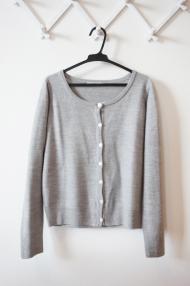
Cardigan: +2.2°C
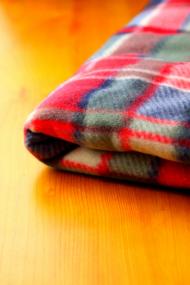
Knee hook: +2.5°C
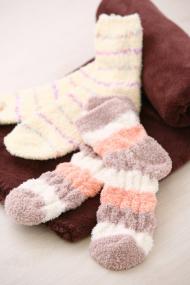
Socks: +0.6°C
Warm Style Tips <Food>
Let's warm your body and room with a pot
While gathering with family and friends and enjoying the pot, warm both the body and the room.

The pot is a dish that can be used as three birds with one stone or four birds, while enjoying conversations with family and friends, warming both the body and the room and suppress heating.
The humidification effect of steam from the pot further increases the perceived temperature.
In general, when the humidity increases, the perceived temperature rises, so even if the heating is suppressed by placing a pot filled with hot water or placing a kettle on the stove and boiling the hot water. It makes it harder to feel cold.
Gather in a room and turn off the heating and lighting of other rooms.
By surrounding the pot and gathering in one room, everyone does not use energy such as heating and lighting in other rooms.
We also focus on ingredients that warm the body, such as seasonal winter, root vegetables, and ginger.

Ingredients in winter, root vegetables, especially ginger, have the effect of warming the body from inside.
By selecting ingredients, "local production for local consumption" can also reduce CO2 emissions related to distribution.
It is also important to keep food from wasting, such as putting the surplus ingredients in the refrigerator into pots.
Let's use a seasoning that warms up your body.
Spices such as peppers and peppers warm the body from inside and encourage sweating.
It also has the effect of warming the gastrointestinal tract and helping digestion and absorption. In addition, thickening with potato starch, etc. will increase heat retention.
It can be expected to warm up the body from the core and maintain warmth.
| Ingredients | Pork roses, Chinese cabbage, radish, shimeji, tofu, and other favorite ingredients |
|---|---|
| Seasonings | Dashi, make the base taste with salt, add ginger slices and grated, and add soy sauce to taste. |
One point |
Chinese cabbage is rich in vitamin C and enhances immunity, making it harder to wind. |
| Ingredients | Pork belly, tofu, Chinese cabbage, green onions, leek, and other favorite ingredients |
|---|---|
| Seasonings | Make the base taste with chicken soup and salt, and add miso, soy sauce and sugar if you like. Let's finish with Kochujan or Shichimi pepper. |
One point |
Even if you put kimchi instead of Chinese cabbage, the taste will be deep. |
Warm Style Tips <Living>
Let's be aware of humidity and raise the perceived temperature
Place a thermometer or hygrometer nearby to "visualize" the indoor environment.
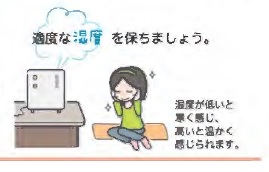
Excerpt from Home Energy Conservation Guide ( Agency for Natural Resources and Energy)
If you stay in the same room for longer, you will feel colder or warmer than it is actually. Place a thermometer or hygrometer to "visualize" the indoor environment, refrain from using wasteful heating, and be careful of poor physical condition due to cooling.
Pay attention to windows and doors
Let's reduce the opening and closing of doors and windows
As the number of openings and closings increases, heat escapes from the room to the outside, and conversely, cold air enters from outside the room.
Let's improve the insulation performance of windows
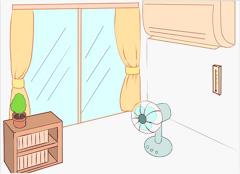
Excerpt from the Agency for Natural Resources and Energy's website "Areasonable Energy Savings"
What is important in the insulation of a house is to increase the insulation performance of the opening. In winter, more than half of the heat escapes from the openings such as windows. Use thick curtains to make sure that heat does not escape from the window. Long curtains that reach the floor are more effective. It is also effective to attach an insulation sheet to the window or change the window to a double glass or double sash.
Let's circulate the warm air.
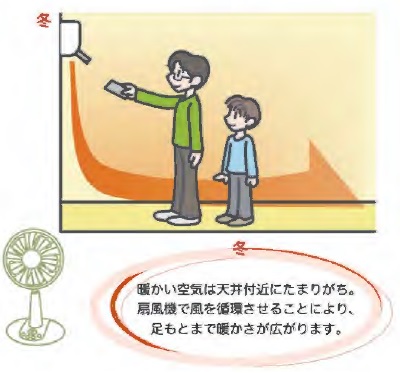
Excerpt from Home Energy Conservation Guide ( Agency for Natural Resources and Energy)
Use a fan together to circulate the warm air.
※Ventilate as appropriate during heating.
Let's devise ways not to rely too much on heating with "tools" and "small items".
Effectively utilize hot-water bags, long-haired slippers, cushions, etc.
The room temperature setting for heating in winter is 20°C!
Let's save money with reasonable energy-saving behavior
Practice the warm-style tips of "clothing", "food" and "house" introduced.
Room temperature is set to 20°C.
By doing so, it can be expected to save about 1.170 yen in the case of air conditioners.
※When the temperature of the air conditioner (2.2 kW) is set from 21 °C to 20 °C when the outside air temperature is 6 °C (use time: 9 hours/day)
In addition, it is expected to save about 1,390 yen for gas fan heaters and 1,020 yen for oil fan heaters.
※When the external air temperature is 6°C, the setting temperature of the heating is set from 21°C to 20°C (use time: 9 hours/day).
There are many other things! Warm style "knowledge"
Let's cherish the time of bathing
Warm your mind and body by taking a bath
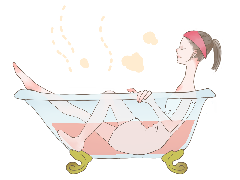
It takes about 20 minutes to warm the body from the core by taking a bath and make it difficult to cool down.
It is effective to use only half body in lukewarm water of about 38 to 39 ° C.
Since hot water is heated and boiled in a small amount, it can save energy and save water, and can also be used in your wallet.
It's a gentle bathing method.
The effect of warming the body with Yuzu, ginger, radish, etc. increases.
Just floating the skin of yuzu and oranges in the bathtub, the components contained in these stimulate the skin and improve blood circulation.
Daikonyu is chopped with radish leaves dried for about a week, placed in a cloth bag, and floated in a bathtub.
Mineral ingredients contained in leaves help promote blood circulation and sweating effect.
It is also effective to run a footbath in a short time.

When the body is cold and hard, but it's still too early to take a bath ...
By storing hot water on a large tub and putting your feet on it, it will be very easy.
After the footbath, wear socks made of functional materials or slippers with long fur.
Let's keep it warm.
Let's warm up the body by exercise

Walking one station for commuting or going to school, or using stairs on the third floor is effective for both body temperature rise and health.
Moving more than usual increases body temperature, activates metabolism, and improves blood circulation.
Use the cold on the other hand to eliminate daily lack of exercise.
Blood circulation promotion exercise that can be done sitting at home or at work
Blood circulation promotion exercises that can be done sitting at home or at work, such as stretching legs and necks, increase metabolism and prevent chills and stiffness.
Energy saving with familiar home appliances
Kotatsu and electric carpets are combined with mattresses and insulation mats.

Add heat insulation mat!
If an electric carpet is placed directly on the floor, heat escapes to the floor and the heating efficiency is reduced.
Place an insulation mat under the electric carpet.
Kotatsu is effective when combined with an upper futon.
Let's turn on the heating only when you need it.
The room temperature does not drop suddenly. Cutting about 15 minutes before going out or going to bed is an energy saving trick.
Don't keep the electric pot warm, but let's boil it again when needed.
Let's get together! "Warm Share"
To save energy consumption by stopping excess heating and gathering together in a single room or place.
"Warm share."
For example, turn off the heating of individual rooms and go out to the city to public facilities such as libraries, museums, and the elementary school student Museum.
By using recreation facilities, etc., you can reduce the amount of energy used as a whole.
About this page
※Warm style tips, data, etc.
Agency for Natural Resources and Energy “Thorough Home Energy Conservation Guide” (2012, 2017 edition) and
Agency for Natural Resources and Energy website
(https://www.enecho.meti.go.jp/category/saving_and_new/saving/general/howto/ (external site))
It is created based on this.
※Don't overdo it and use the heating properly according to your physical condition.
Inquiries to this page
Seya Ward General Affairs Department Ward Administration Promotion Division Planning and Adjustment Section
Telephone: 045-367-5632
Telephone: 045-367-5632
Fax: 045-365-1170
Email address: se-kusei@city.yokohama.jp
Page ID: 982-412-925













